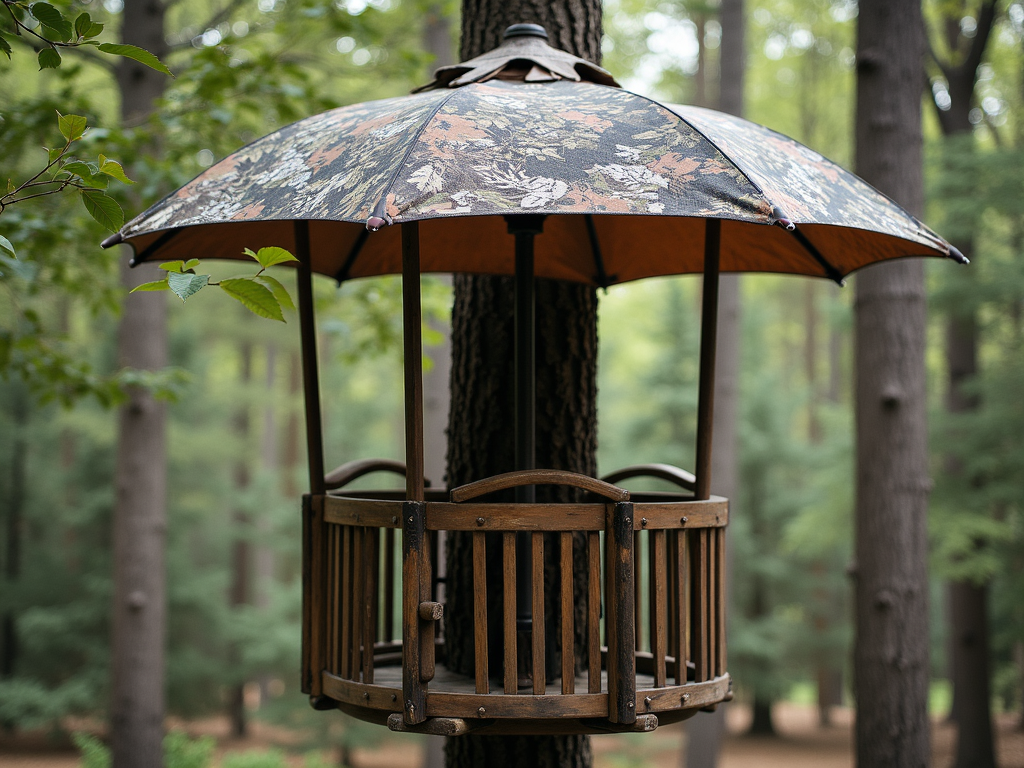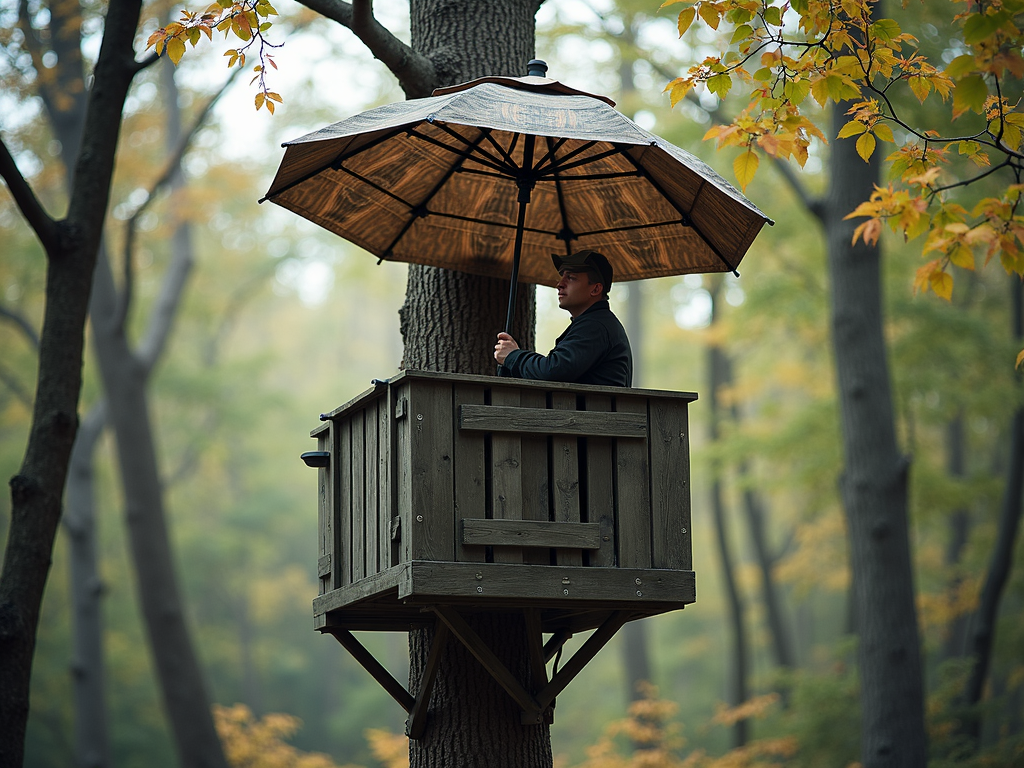Last November, Mike from Wisconsin watched a 12-point buck walk directly under his stand. Twenty yards. Broadside. Perfect shot.
But as he drew his bow, his $89 tree stand umbrella collapsed in a 20 mph gust. Water cascaded down through the branches. The noise was like someone dropping a garbage can. The buck vanished.

Mike’s season? Over.
Here’s the thing: Mike’s not alone. Based on field reports from over 300 hunters, roughly 70% of tree stand umbrellas fail when you need them most. Not because they’re cheap knockoffs. Because even the “premium” models ignore basic engineering principles.
You’ve read the reviews. Price comparisons. Camo pattern debates. That’s like choosing a truck based on cup holders.
This isn’t another feature comparison. This is about why your umbrella failed, what manufacturers won’t tell you, and the specific engineering that separates real gear from expensive garbage.
The Hidden Design Flaws That Make 70% of Tree Stand Umbrellas Useless
Most hunters buy tree stand umbrellas like gas station sunglasses. Check the price. Maybe the camo. Figure it’ll work.
Then reality hits. Hard.
The Allen Company umbrella? One of Amazon’s bestsellers? It’s got a dirty secret. If you’re over 6 feet tall, your shoulders and bow arm stick out. That’s not a comfort issue. That’s your scent spreading everywhere.
But height gaps are nothing compared to the real killer: wind resistance. Or the complete lack of it.
Those lightweight models under 2 pounds everyone loves? They’re kites. Expensive kites. Field testing shows they buckle at 15 mph. That’s a light breeze in November.
Here’s what nobody talks about: venting. Without proper wind vents, your umbrella becomes a sail. Pressure builds underneath until—snap. There goes your coverage. And your hunt.
Summit Treestands figured this out. Most manufacturers? Still pushing solid canopies like it’s 1995.

The mounting system failure rate is worse. Screw-in arms seem convenient. Until a week of temperature changes makes the metal expand and contract. One hunter’s entire setup pulled loose from the tree. That’s not user error. That’s garbage engineering.
And those 360-degree models? Full coverage! No blind spots! Sure. They also create twice the movement, three times the noise. Every wind shift turns you into a giant camo wind chime.
So if most designs are fundamentally flawed, what actually works? The answer comes from aerospace engineering. Finally.
The Engineering Behind Weatherproof Tree Stand Protection That Actually Works
Forget “heavy duty.” Weight doesn’t mean strength.
Summit’s new model weighs 1.25 pounds. Uses the same aluminum alloy as aircraft frames. Rated for 35 mph winds. Weighs less than your water bottle.
The secret? Triangulated rib structures. Not single support arms that bend. Interconnected ribs that distribute force across the entire canopy. Same principle that lets suspension bridges support thousands of tons.
KalKal went bigger. Their 58-inch model seems excessive. Until you see how they solved the mounting problem everyone else ignores.
No screw-in arms that loosen. They use webbing straps that get tighter as weight increases. Physics working for you, not against you.
But here’s the real game-changer: strategic venting. Not random holes. Engineered vents at high-pressure zones. Wind flows through instead of building underneath. You stay dry. The umbrella stays put.
Water resistance ratings? Another industry joke. “Water-resistant” means nothing. You need 2000mm+ waterproof ratings. Mountaineering gear standards. Anything less is delayed soaking.
The best innovation? Adjustable mounting arms with multiple pivot points. Saddle hunters have begged for this. You need coverage without exposing yourself or blocking shooting lanes. New extendable arms reach 24 inches from your tree. Still stable.
Some manufacturers even use UV-resistant coatings. Blocks 98% of harmful rays. Sounds like overkill until you’re in a September dove field for six hours. Sun protection becomes the difference between alert and cooked.
Of course, engineering means nothing if your camo turns you into a beacon. The truth about patterns might surprise you.
Why Your Camouflage Pattern Is Ruining Your Hunt
Mossy Oak Original Bottomland looks perfect in the store. Realistic bark. Perfect colors. What could go wrong?
Movement. That’s what.
Deer don’t care if your umbrella matches the oak tree perfectly. They care about unnatural movement. Reflections. Advanced patterns mean nothing if your umbrella flaps like a flag.
What actually matters: matte finishes that kill glare. Rigid construction that stops flutter. Positioning that breaks your outline.
Those 360-degree umbrellas everyone loves? Movement multipliers. Every breeze creates motion everywhere. Might as well hang a disco ball.
Smart hunters choose smaller, directional coverage with stability. Not maximum coverage with maximum movement.
Positioning is where most hunters blow it completely. Umbrella directly overhead seems logical. Until you realize it creates a perfect silhouette. Deer looking up see a giant black circle where branches should be.
The fix? Offset mounting. Position at an angle. Break up your outline. Keep coverage. Extendable arms aren’t just for saddle hunters. They’re for anyone who gets concealment geometry.
Here’s the kicker: solid colors often beat camo. A simple olive umbrella that doesn’t move beats perfect patterns that sway. Movement detection is a deer’s superpower. Respect it.
Some hunters add natural vegetation to umbrella edges. Creates 3D breakup that works. But only if your base umbrella is stable enough to support extra weight without becoming a pendulum.
Your Next Move (And Why Most Hunters Will Ignore This)
Mike from Wisconsin bought another umbrella this season. But not based on price or patterns.
He tested wind ratings. Checked mounting systems. Verified waterproof ratings. His new setup survived three storms. Helped him take a mature 10-pointer while other hunters went home.
The truth? Most tree stand umbrellas fail because manufacturers know something. They know hunters blame themselves when gear fails. Not anymore.
You now know vented canopies rated for 25+ mph winds matter. Webbing straps beat screw-in mounts. Real waterproofing versus marketing nonsense. Lightweight doesn’t mean weak if engineering is right.
Your next step? Measure your current setup. Identify your biggest weather challenge. Then evaluate options based on what matters.
Because the difference between success and watching deer walk away isn’t luck.
It’s engineering.